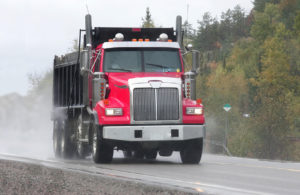 San Diego is home to more than half a million homes and over 85,000 businesses, and the city only expects to grow in the coming decades.
San Diego is home to more than half a million homes and over 85,000 businesses, and the city only expects to grow in the coming decades.
All the residents and businesses in San Diego create waste that trash service companies collect regularly. This requires garbage trucks to travel busy arterial roadways and residential roadways in the city limits. Expected population and economic growth will require more dump and garbage trucks to keep up with increased waste.
While they serve a critical purpose, dump and garbage trucks pose risks to San Diego residents and visitors. With their size and difficulty maneuvering, these vehicles can sometimes end up in accidents that cause serious injuries to the occupants of motor vehicles, motorcycle riders, pedestrians, and bicyclists.
This blog provides a broad overview of San Diego dump and garbage truck accidents, potential injuries, and how victims can recover compensation. If a dump or garbage truck injured you in San Diego, you should consult with an experienced truck accident attorney to determine your options in your specific case.
[lwptoc]
San Diego Dump and Garbage Trucks: Big Trucks, Big Risks
Dump trucks and garbage trucks are used for different reasons in San Diego, yet they are both large, heavy trucks that present similar hazards as other types of large commercial vehicles, such as tractor-trailers or city buses. Large trucks are responsible for more than 4,000 deaths on U.S. roads each year. Thousands of people suffer serious and incapacitating injuries in collisions with large trucks, which are 20 to 30 times heavier than the average passenger car.
San Diego dump and garbage trucks pose many potential hazards, including:
- An increased distance needed to stop the vehicle. It takes time and space for the brakes to safely stop a vehicle. The heavier the vehicle, the more distance the brakes need. Other factors, such as the speed of the truck and road and weather conditions, affect this distance.
- Significant blind spots. All vehicles have blind spots the driver cannot see with their rear- or side-view mirrors. Passenger cars have blind spots around the rear sides of the vehicle. The larger the vehicle, the bigger the blind spot. Garbage and dump trucks have significant blind spots on all four sides, presenting an increased risk of striking others, especially smaller bicyclists and pedestrians, while attempting to turn, back up, or change lanes.
- Wide turns. The size of San Diego dump and garbage trucks are also harder to operate when it comes to turns, as drivers must make wider turns to avoid hitting curbs and other objects. This results in the truck encroaching into other travel lanes, creating a hazard for travelers occupying those lanes.
Hazards of San Diego Dump Trucks
The risks created by San Diego dump trucks, go beyond other drivers and include those created by workers at the construction sites.
Specific hazards associated with this type of vehicle include:
- Loss of control of the vehicle on paths due to improperly maintained tires. These trucks can carry around 14 tons of cargo, which places strain on the tires. Worn tires have a greater likelihood of blowing out and will often pull the vehicle sharply to one side. A construction site’s often unpaved and pothole-riddled roads further expose a dump truck’s tires to the risk of blowing out and causing the driver to lose control.
- Improperly loaded cargo. With all the weight a dump truck can carry, the load must be spread evenly throughout the bed to prevent a dangerous rollover. Dump trucks may roll over if the weight is not balanced, especially given the high center of gravity and top-heavy design of the trucks.
- Errors in dumping technique. Dump truck drivers must dump their loads carefully. While the bed raises to dump, the truck is at higher risk of overturning, which is extremely dangerous for the driver and anyone standing nearby.
- Materials blowing or falling from the truck. Materials coming loose from a truck and flying out toward other vehicles and pedestrians can cause extremely dangerous injuries, especially on a fast-paced highway. Dump trucks don’t just carry paper and other light trash you may have in your trash can, but rather include heavy and sharp objects that can break the windshields of other vehicles, resulting in serious injury or death.
Hazards of San Diego Garbage Trucks
San Diego garbage trucks also present unique risks for both the garbage truck workers and others. Garbage collecting routinely appears high on the list of the most dangerous jobs in the U.S. Even the drivers face danger from hazardous materials thrown in garbage cans, running into overhead obstacles such as low-hanging electrical wires, and being hit by distracted drivers when stepping out of the truck to manually collect trash.
Truck drivers also pose significant risks to other drivers. One of the greatest risks to other road users is a simple consequence of garbage trucks’ frequent travel, and frequent stopping on narrow, residential streets that were not designed for garbage trucks. Due to a garbage truck’s large blindspots, it is difficult for the driver to see other vehicles or pedestrians as they navigate tight residential roads.
Other potential hazards of San Diego garbage trucks include:
- Driving distractions. A garbage truck driver is often planning their route, focusing on pickups, communicating with dispatchers, and navigating to avoid collisions with street-side parked cars all at once. The many demands on the truck driver’s attention result in the driver losing focus on other aspects of driving safely. They may fail to notice traffic signs or to make sure the area behind them is free of other vehicles, pedestrians, or bicyclists before backing up to pick up a load.
- Navigating the vehicle safely through traffic congestion. Garbage trucks not only collect trash from residential neighborhoods but from businesses, including those along the busiest non-freeway roads in San Diego. Traffic congestion places more vehicles in garbage truck blind spots, increasing the risk of rear-end and sideswipe accidents on busy highways, or broadside (T-bone) crashes at intersections.
Injuries In San Diego Dump & Garbage Truck Accidents
Like other types of accidents involving large trucks, those involving San Diego dump and garbage trucks can produce serious injuries.
These injuries can include:
- Traumatic brain injuries (TBI), which involve damage to the brain from a blow to the head or body. Because the brain controls nearly every function of the body, TBIs often produce memory loss, inability to control behavior or emotions, difficulty speaking or understanding spoken communication, inability to move in a balanced and coordinated manner, blindness or loss of the ability to perceive the size and shape of objects, loss of awareness of abilities and limitations, and more.
- Spinal cord injuries, which damage the bundle of nerves located in the spinal column that serve as a messaging system between the brain and the rest of the body. Spinal cord injuries often result in paralysis, which is the loss of sensation and function below the injury. Paralysis—particularly if it involves the chest and abdomen—can create many complications, including an inability to sense heat or cold on the surface of the skin; an increased risk of infections, such as urinary tract infections; pneumonia, resulting from the inability to cough up secretions from the lungs and throat; and the inability to conduct personal care tasks independently.
- Damage to the spinal vertebrae and discs, which can result in mobility loss, chronic pain, and the need for surgery to stabilize the spine.
- Severely crushed or amputated limbs, resulting from being caught between heavy objects and surfaces in a collision.
- Internal injuries, which can result in organ failure or life-threatening blood loss.
- Broken bones, which can result in mobility loss, chronic pain, or even shortening of the affected bone.
- Chemical burns and exposure to toxins that have been placed in a garbage can.
- Injuries resulting from an object flying or falling from the back of the truck and striking someone behind, such as a pedestrian, or another driver if the object is substantial enough to pierce the windshield of the vehicle.
Seeking Compensation for San Diego Dump And Garbage Injuries
Individuals who are injured by San Diego dump and garbage truck accidents can seek compensation for their expenses.
The claim must prove the expenses and impacts the victim suffered in the accident, including those that the victim will likely suffer in the future. You must bring a dump or garbage truck accident lawsuit within two years of the accident, although the law makes a few exceptions. Contact an attorney as soon after an accident as possible to make sure you file a timely claim.
Proving Liability
To have a successful outcome to your San Diego dump or garbage truck claim, you must be able to show who was liable for the accident.
You do this by establishing:
- The at-fault party owed you a duty of care. Duty of care simply refers to what a reasonable person would do to prevent others from harm. A dump or garbage truck driver owes a duty to operate their vehicle safely by following federal, state, and local laws.
- There was a breach in the duty of care. This refers to what the at-fault party did that violated the duty of care.
- The breach resulted in the accident and caused the injuries and impacts for which you are demanding compensation.
Recovering Damages
Recovering damages means obtaining compensation for the harm you suffered. In a San Diego dump or garbage truck accident case, you can recover economic damages and non-economic damages. These damages compensate you for the expenses and impacts, both monetary and nonmonetary, you have experienced from the dump or garbage truck accident.
Some expenses and impacts for which you may recover damages in San Diego dump and garbage truck accident cases include:
- Medical expenses, such as emergency treatment, ambulance transport, diagnostic testing, hospitalization, the services of your physician or surgeon, medical supplies used for your treatment, prescription medication, physical therapy, rehabilitation, and devices such as a wheelchair, crutches, or prosthetic limbs
- Lost wages, for the time you are unable to work and earn income, due to your injuries
- Loss of future earning capacity, if you are left permanently disabled by your injury and can no longer earn an income
- Property damage, such as the cost of repairing or replacing your vehicle
- Physical pain and suffering
- Emotional distress
- Loss of the enjoyment of life, if your injury results in the inability to participate in activities you previously enjoyed
- Loss of consortium, if the accident leaves you unable to enjoy physical intimacy with a spouse or partner. Your partner may also have a loss of consortium claim.







